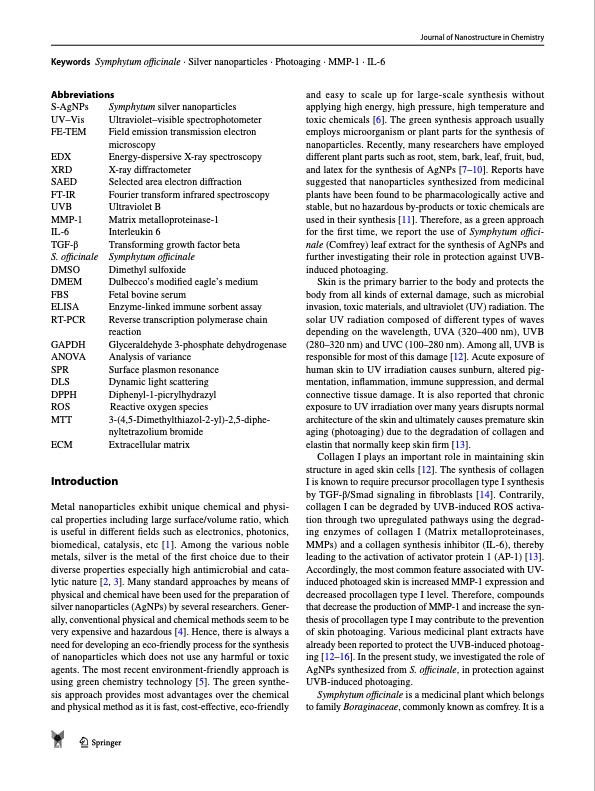
PDF Publication Title:
Text from PDF Page: 002
Keywords Symphytum officinale · Silver nanoparticles · Photoaging · MMP-1 · IL-6 Abbreviations and easy to scale up for large-scale synthesis without applying high energy, high pressure, high temperature and toxic chemicals [6]. The green synthesis approach usually employs microorganism or plant parts for the synthesis of nanoparticles. Recently, many researchers have employed different plant parts such as root, stem, bark, leaf, fruit, bud, and latex for the synthesis of AgNPs [7–10]. Reports have suggested that nanoparticles synthesized from medicinal plants have been found to be pharmacologically active and stable, but no hazardous by-products or toxic chemicals are used in their synthesis [11]. Therefore, as a green approach for the first time, we report the use of Symphytum offici- nale (Comfrey) leaf extract for the synthesis of AgNPs and further investigating their role in protection against UVB- induced photoaging. Skin is the primary barrier to the body and protects the body from all kinds of external damage, such as microbial invasion, toxic materials, and ultraviolet (UV) radiation. The solar UV radiation composed of different types of waves depending on the wavelength, UVA (320–400 nm), UVB (280–320 nm) and UVC (100–280 nm). Among all, UVB is responsible for most of this damage [12]. Acute exposure of human skin to UV irradiation causes sunburn, altered pig- mentation, inflammation, immune suppression, and dermal connective tissue damage. It is also reported that chronic exposure to UV irradiation over many years disrupts normal architecture of the skin and ultimately causes premature skin aging (photoaging) due to the degradation of collagen and elastin that normally keep skin firm [13]. Collagen I plays an important role in maintaining skin structure in aged skin cells [12]. The synthesis of collagen I is known to require precursor procollagen type I synthesis by TGF-β/Smad signaling in fibroblasts [14]. Contrarily, collagen I can be degraded by UVB-induced ROS activa- tion through two upregulated pathways using the degrad- ing enzymes of collagen I (Matrix metalloproteinases, MMPs) and a collagen synthesis inhibitor (IL-6), thereby leading to the activation of activator protein 1 (AP-1) [13]. Accordingly, the most common feature associated with UV- induced photoaged skin is increased MMP-1 expression and decreased procollagen type I level. Therefore, compounds that decrease the production of MMP-1 and increase the syn- thesis of procollagen type I may contribute to the prevention of skin photoaging. Various medicinal plant extracts have already been reported to protect the UVB-induced photoag- ing [12–16]. In the present study, we investigated the role of AgNPs synthesized from S. officinale, in protection against UVB-induced photoaging. Symphytum officinale is a medicinal plant which belongs to family Boraginaceae, commonly known as comfrey. It is a S-AgNPs UV–Vis FE-TEM EDX XRD SAED FT-IR UVB MMP-1 IL-6 TGF-β S. officinale DMSO DMEM FBS ELISA RT-PCR GAPDH ANOVA SPR DLS DPPH ROS MTT ECM Symphytum silver nanoparticles Ultraviolet–visible spectrophotometer Field emission transmission electron microscopy Energy-dispersive X-ray spectroscopy X-ray diffractometer Selected area electron diffraction Fourier transform infrared spectroscopy Ultraviolet B Matrix metalloproteinase-1 Interleukin 6 Transforming growth factor beta Symphytum officinale Dimethyl sulfoxide Dulbecco’s modified eagle’s medium Fetal bovine serum Enzyme-linked immune sorbent assay Reverse transcription polymerase chain reaction Glyceraldehyde 3-phosphate dehydrogenase Analysis of variance Surface plasmon resonance Dynamic light scattering Diphenyl-1-picrylhydrazyl Reactive oxygen species 3-(4,5-Dimethylthiazol-2-yl)-2,5-diphe- nyltetrazolium bromide Extracellular matrix Introduction Metal nanoparticles exhibit unique chemical and physi- cal properties including large surface/volume ratio, which is useful in different fields such as electronics, photonics, biomedical, catalysis, etc [1]. Among the various noble metals, silver is the metal of the first choice due to their diverse properties especially high antimicrobial and cata- lytic nature [2, 3]. Many standard approaches by means of physical and chemical have been used for the preparation of silver nanoparticles (AgNPs) by several researchers. Gener- ally, conventional physical and chemical methods seem to be very expensive and hazardous [4]. Hence, there is always a need for developing an eco-friendly process for the synthesis of nanoparticles which does not use any harmful or toxic agents. The most recent environment-friendly approach is using green chemistry technology [5]. The green synthe- sis approach provides most advantages over the chemical and physical method as it is fast, cost-effective, eco-friendly Journal of Nanostructure in Chemistry 13PDF Image | green silver nanoparticles from leaf used as UVb protection

PDF Search Title:
green silver nanoparticles from leaf used as UVb protectionOriginal File Name Searched:
Role_of_green_silver_nanoparticles_synthesized_fro.pdfDIY PDF Search: Google It | Yahoo | Bing
Turbine and System Plans CAD CAM: Special for this month, any plans are $10,000 for complete Cad/Cam blueprints. License is for one build. Try before you buy a production license. More Info
Waste Heat Power Technology: Organic Rankine Cycle uses waste heat to make electricity, shaft horsepower and cooling. More Info
All Turbine and System Products: Infinity Turbine ORD systems, turbine generator sets, build plans and more to use your waste heat from 30C to 100C. More Info
CO2 Phase Change Demonstrator: CO2 goes supercritical at 30 C. This is a experimental platform which you can use to demonstrate phase change with low heat. Includes integration area for small CO2 turbine, static generator, and more. This can also be used for a GTL Gas to Liquids experimental platform. More Info
Introducing the Infinity Turbine Products Infinity Turbine develops and builds systems for making power from waste heat. It also is working on innovative strategies for storing, making, and deploying energy. More Info
Need Strategy? Use our Consulting and analyst services Infinity Turbine LLC is pleased to announce its consulting and analyst services. We have worked in the renewable energy industry as a researcher, developing sales and markets, along with may inventions and innovations. More Info
Made in USA with Global Energy Millennial Web Engine These pages were made with the Global Energy Web PDF Engine using Filemaker (Claris) software.
Infinity Turbine Developing Spinning Disc Reactor SDR or Spinning Disc Reactors reduce processing time for liquid production of Silver Nanoparticles.
| CONTACT TEL: 608-238-6001 Email: greg@infinityturbine.com | RSS | AMP |